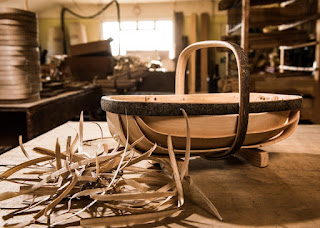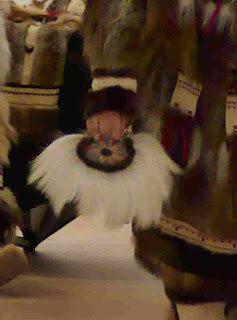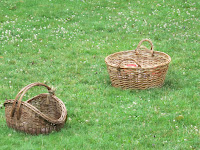The basket buzz this month comes from the fabulous portrait photograph of HRH Camilla, Duchess of Cornwall, taken by HRH Catherine “Kate” Middleton, Duchess of Cambridge, which appears on the cover of Country Life magazine, released on July 13, 2022.
Camilla is casually posed in her garden at Clarence House, sitting with what has been widely described as a 'basket of flowers.' This “basket” is oval/rectangular and is cradled by two attached wooden supports perpendicular to its base. It is made of light colored willow, longitudinal pieces which are overlapped and not interwoven. Another material, sweet chestnut, is used for the bail handle and the splint around the exterior rim. I did a lot of internet searching to find out more about this wooden container type basket. Writing for Woman and Home, Emma Shacklock describes Camilla as posing with “a basket of fresh cut pink flowers displayed in a trough alongside her.” The use of the word "trough" here, instead of basket, is closer to the correct term for the Duchess's handled container. The flowers are also named; Simon Perry's article in People tells us that the basket is “filled with pelargoniums, which are ready to be planted.”
The name of the container was revealed by Mark Hedges, Country Life editor, quoted in a Newsweek article: "The photograph of Camilla is extremely traditional with the attributes of a conventional countrywoman including sensible knit cardigan, floral print dress and obligatory trug basket containing cut flowers."
It's a trug! An old word, yet a new word for me for this form of container, generally described as a wooden basket primarily used to carry gardening supplies and produce.
According to "A Brief History of Mr. Smith's Trugs" https://www.sussextrugs.com/history/, heavy wooden "trogs" had been in use since at least the 1500s, but the development of today's trug dates to the 1820s and is credited to Thomas Smith of Herstmoneux, Sussex, in southeastern England. Smith made his trug, a lighter weight version of the trog, using Sweet Chestnut (Castanea sativa) and Willow (Salix coerulea), both prevalent in the Sussex area. Sustainability is important; the chestnut is coppiced, or cut back, to increase growth. Cutting it at a 45 degree angle lets rain water flow off of the cut, thereby preventing rot and allowing for new growth. Although willow still grows nearby, the boards used in trug making are obtained from the cricket bat industry, in which rejected willow pieces or clefts are recycled by the trug artists. Three willow trees are planted for each harvested tree.
A simplified explanation of making a trug begins with cleaving a sweet chestnut pole with a cleaving axe hammered into the end using a maul made of chestnut wood. The artisan sits then on a shaving horse and uses a draw knife to shave the chestnut until the desired size is achieved. Next, the chestnut is steamed and bent around a "former," a wooden form standardized to the specific style and size of the trug being made. The chestnut forms the frame, and the willow boards, which are also shaped using draw knives, are secured by copper tacks. Trugs vary in shape and size, but are made using the same techniques.
 |
| Craftsmen Caleb Pimm and Mike Harding sit on shaving horses and use draw knives and trained eyes to shave sweet chestnut to the correct size needed to make a specific trug. |
 |
| A collection of formers on the wall of the Cuckmere Trug Company, Thomas Smith's Trug Shop. |
Where did Camilla get her trug? I traced it to Robin M. Tuppen, Proprietor, Yeoman Member of the Worshipful Company of Basketmakers, Thomas Smith’s Trug Shop, Part of the Cuckmere Trug Company, Herstmonceux, East Sussex.
In my email exchange with Robin Tuppen, he wrote, "I can definitely confirm that the Trug being used by Camilla is one of ours. This was ordered by Clarence House sometime last year and they sent a courier down to collect the Trug from us especially (so it appears) for this photographic session! It is a Royal Sussex Garden Trug in Size No. 6."
And this fine trug is not Camilla's first. In a web interview with Gerry Jones of Merchants and Makers, Robin Tuppen remarked: "Plumpton College presented the Duchess of Cornwall with a bottle of their homemade wine from their own vineyard in one of our ‘Cucumber’ trugs." Tuppen also explained the trug numbering system, "with each number reflecting how many pints it holds, i.e. a Number 1 holds one pint, going up to a Number 8 which measured four gallons."
Sussex remains the home of trug making, and Herstmonceux is the heart of it. True Sussex Trugs originate in Sussex and are made by several workshops (see https://heritagecrafts.org.uk/sussex-trug-making/). Many of the artisans belong to The Association of Sussex Trug Basketmakers, The Basketmakers’ Association, and The Worshipful Company of Basketmakers. Royal Sussex Trugs, such as Camilla's, are specifically from the Cuckmere Trug Company, Thomas Smith’s Trug Shop, each one signed and dated by the artisan and stamped as genuine.
 |
| A completed Royal Sussex Trug alongside sweet chestnut shavings. |
"Our Trugs are called 'Royal' as our founder, Thomas Smith, sold some of his Trugs to Queen Victoria personally on the first day of the Great Exhibition in the Crystal Palace in Hyde Park [1851]. He was later awarded her Royal Warrant," according to Robin Tuppen via email. The Royal Warrant Holders Association defines a Royal Warrant of Appointment as "a mark of recognition of those who have supplied goods or services to the Households of HM The Queen or HRH The Prince of Wales for at least five years, and who have an ongoing trading arrangement." https://www.royalwarrant.org/.
On the Red List of Endangered Crafts, Sussex trug making holds "endangered" status, with fewer than two dozen practioners, from apprentices through master craftsmen. The craft's viability is affected by foreign competition and customers' "lack of awareness" of the differences between genuine Sussex trugs and imitations.
Although imitation is the sincerest form of flattery, if one is looking for a genuine Sussex trug, one must look to Sussex.














 ka.
ka.





